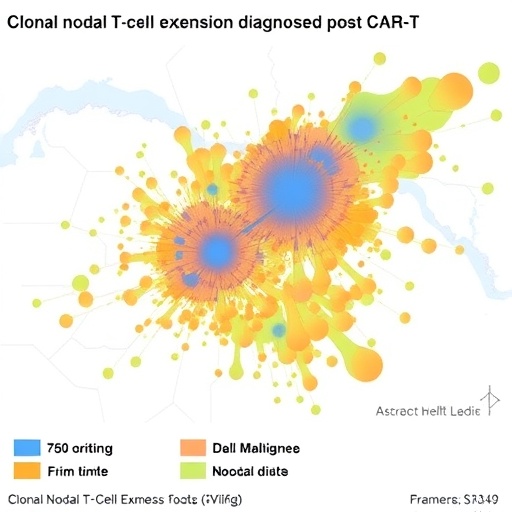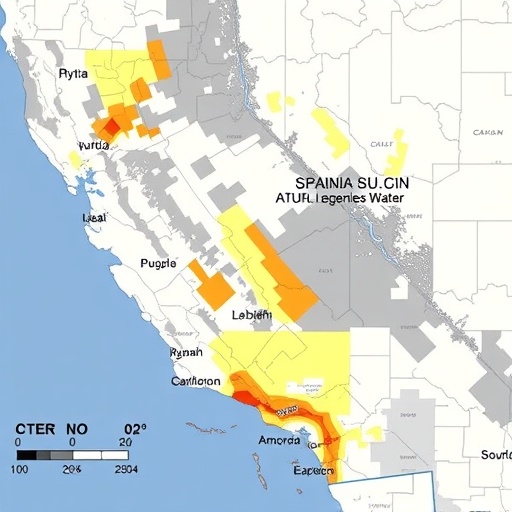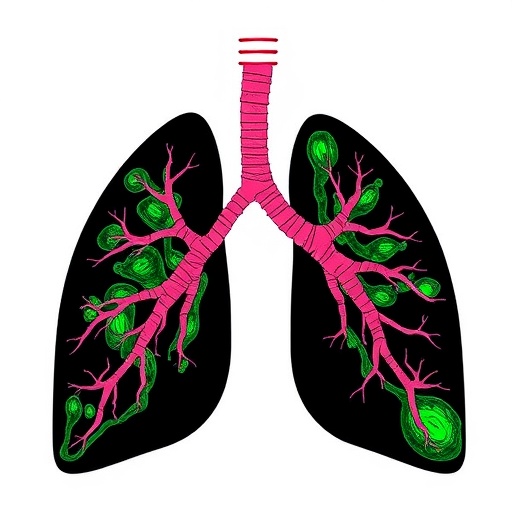
In the evolving landscape of cancer immunotherapy, chimeric antigen receptor T-cell (CAR-T) therapy has emerged as a groundbreaking treatment capable of reinvigorating the immune system to fight hematologic malignancies. This transformative therapy, which involves engineering patients’ own T-cells to target and destroy cancerous cells, has shown remarkable success in treating certain lymphomas and leukemias. However, as with many revolutionary therapies, deeper insights from longitudinal patient monitoring reveal unexpected complexities. A recent study published in Nature Communications by Maurer et al. illuminates a novel and concerning clinical observation: the emergence of a clonally expanded nodal T-cell population culminating in a diagnosis of T-cell lymphoma following CAR-T therapy.
The immune system is a finely balanced network, and CAR-T cell therapy specifically harnesses and enhances T-cell mediated cytotoxicity. Typically, engineered CAR-T cells are directed against B-cell antigens such as CD19, which are expressed on malignant B cells in conditions like diffuse large B-cell lymphoma or acute lymphoblastic leukemia. The selective targeting and elimination of these malignant B cells have revolutionized outcomes for many patients, fostering complete remission where conventional therapies often failed. Yet, the immunological milieu post-CAR-T therapy is far from static. The therapeutic intervention exerts selective pressures that can potentially reshape the T-cell compartments within lymphoid tissues.
In the study by Maurer and colleagues, the researchers report on a patient whose disease course following CAR-T cell infusion deviated unexpectedly. Instead of experiencing a sustained remission, the patient developed an abnormal clonal expansion of T-cells localized within lymph nodes. This expansion, upon rigorous pathological and molecular characterization, was diagnosed as a T-cell lymphoma. This case contrasts sharply with the typical expectations post-CAR-T therapy, where the primary malignancy often involves B-cell lineage cells that are targeted and eliminated by the engineered CAR-T cells. The emergence of a clonally distinct T-cell malignancy underscores an unforeseen complexity in immunomodulatory therapy outcomes.
.adsslot_hH8ILgEdB6{width:728px !important;height:90px !important;}
@media(max-width:1199px){ .adsslot_hH8ILgEdB6{width:468px !important;height:60px !important;}
}
@media(max-width:767px){ .adsslot_hH8ILgEdB6{width:320px !important;height:50px !important;}
}
ADVERTISEMENT
Delving into the mechanisms, one can infer that CAR-T therapy may inadvertently reshape the immune microenvironment. The depletion of B-cell populations and accompanying inflammatory responses create a niche ripe for clonal selection and expansion of certain T-cell subsets. In this context, the study highlights how T-cell populations within lymph nodes, which are inherently heterogeneous and subordinate to normal immunoregulatory mechanisms, may acquire proliferative advantages or evade apoptotic signals leading to clonal dominance. This clonal expansion, if harboring oncogenic mutations or epigenetic alterations, could manifest as overt lymphoma.
The comprehensive immunophenotyping techniques employed in the study allowed for precise delineation of the aberrant T-cell compartment. Flow cytometry combined with single-cell RNA sequencing revealed that the expanded T-cell cluster expressed markers consistent with a malignant phenotype, distinct from residual CAR-T cells or reactive non-malignant T-cell populations. The molecular profile exhibited characteristic rearrangements and transcriptional signatures aligning with known T-cell lymphomas, thereby substantiating the final diagnosis. Furthermore, histopathological examination of lymph node biopsies confirmed nodal architectural disruption typical of lymphomatous infiltration.
This finding carries sobering implications for the monitoring protocols and post-therapy surveillance of CAR-T recipients. While initial approvals and clinical trials have primarily focused on efficacy and short-term toxicity, this evidence mandates a closer look at the long-term consequences on lymphoid homeostasis. Lymphomas arising from T-cell lineages post-CAR-T therapy could complicate clinical management, as therapeutic strategies for T-cell lymphoma differ significantly from those for B-cell malignancies. Moreover, such secondary malignancies may emerge as resistant clones, unresponsive to subsequent immunotherapies.
The study also prompts further inquiry into the molecular drivers underpinning the clonal expansion. Are these secondary lymphomas the result of therapy-induced selection pressures, or do they reflect secondary mutagenesis facilitated by the inflammatory milieu? It is conceivable that in the process of immune activation and cellular proliferation triggered by CAR-T therapy, genomic instability in existing T-cell populations may be unmasked, leading to malignant transformation. Alternatively, the immunosuppressive post-therapy environment might thwart normal immune surveillance mechanisms, allowing pre-existing malignant clones to flourish.
From a translational standpoint, the research calls for the development of robust biomarkers capable of early detection of aberrant T-cell expansions post-CAR-T therapy. Longitudinal monitoring of T-cell clonality and function through high-sensitivity sequencing and phenotyping could potentially predict patients at risk for developing such complications. The integration of this knowledge into clinical algorithms would enhance patient safety and improve long-term outcomes.
The broader significance of this study resonates with the intricate balance within adoptive cellular therapies where on-target, off-tumor effects and immune reconstitution dynamics interweave complexly. The immune re-engineering achieved through CAR-T cells is undeniably revolutionary but comes with inherent risks linked to the plasticity and adaptability of the immune system. This case exemplifies how novel therapies can reveal new facets of oncogenesis, particularly when the immune system itself becomes part of the disease process.
Intriguingly, the clonally expanded T-cell population differed immunophenotypically from the infused CAR-T cells, indicating that the secondary lymphoma was not simply a transformation of the engineered cells but rather represented an independent malignant event. This distinction is critical because it shapes therapeutic decision-making, as targeting residual CAR-T cells would not address the secondary lymphoma adequately.
The insights from Maurer et al. raise pivotal questions regarding the potential for similar phenomena in other immunotherapeutic approaches. As immune checkpoint inhibitors, bispecific antibodies, and next-generation cellular therapies become increasingly prevalent, understanding the mechanisms by which immune manipulation might unintentionally foster secondary malignancies becomes imperative.
In terms of therapeutic options, the emergence of a secondary T-cell lymphoma after CAR-T therapy presents formidable challenges. Treatment modalities should carefully consider prior therapies, immune status, and the underlying disease biology. Approaches might include conventional chemotherapy regimens tailored to T-cell lymphoma, targeted therapies emerging from molecular profiling, or even newer cellular therapies that circumvent the pitfalls observed here. Nevertheless, the risk-benefit calculus in this context is markedly more complex.
The study’s detailed molecular and immunological profiling provides a template for future investigations. Integrating multi-omics approaches—genomics, transcriptomics, epigenomics—will be essential to fully elucidate the pathways driving such secondary lymphoproliferative disorders. Additionally, animal models replicating CAR-T therapy-induced immune alterations could further clarify causative mechanisms and therapeutic vulnerabilities.
The implications for patient counseling are equally profound. Patients receiving CAR-T therapy should be informed not only about the immediate risks and benefits but also about the potential for rare, delayed complications including secondary malignancies. Surveillance strategies must be adjusted accordingly, with interdisciplinary collaboration among oncologists, immunologists, and pathologists to identify early signs of aberrant clonal expansions.
Ultimately, this study spotlights the dynamic interplay between innovative therapies and the complexities of human immunobiology. While CAR-T therapy heralds a new era in cancer treatment, the story it tells is one of caution and continued vigilance. Recognizing and characterizing unintended consequences such as secondary lymphomas directs future research towards safer, more effective immunotherapeutic designs.
As cancer treatment paradigms continue to evolve, the lessons from this case reinforce the necessity of comprehensive long-term follow-up and mechanistic studies. The promise of cellular engineering is immense, yet wielding such power over the immune system demands an equally rigorous understanding of potential pitfalls. Maurer et al.’s meticulous work in documenting a clonally expanded nodal T-cell lymphoma post-CAR-T therapy enhances our knowledge and challenges the scientific community to refine these therapies thoughtfully.
Emerging from this study is a call to action: to decode the molecular and immunological sequelae of immunotherapies fully, to tailor monitoring accordingly, and to develop strategies that anticipate and mitigate such secondary pathologies. Only through such comprehensive efforts can the full potential of CAR-T and related therapies be harnessed safely, fulfilling the promise of precision oncology.
Subject of Research: The development of clonally expanded nodal T-cell lymphoma following CAR-T cell therapy in cancer patients.
Article Title: A clonally expanded nodal T-cell population diagnosed as T-cell lymphoma after CAR-T therapy.
Article References:
Maurer, K., Weir, J.A., Nagler, A. et al. A clonally expanded nodal T-cell population diagnosed as T-cell lymphoma after CAR-T therapy. Nat Commun 16, 7462 (2025). https://doi.org/10.1038/s41467-025-62709-7
Image Credits: AI Generated
Tags: B-cell antigen targetingcancer immunotherapy advancementsCAR-T therapy complicationsclonal T-cell expansionengineered T-cellshematologic malignancies treatmentimmune system dynamicslongitudinal study in cancer researchlymphoma treatment outcomespatient monitoring in CAR-TT-cell lymphoma diagnosisT-cell mediated cytotoxicity





